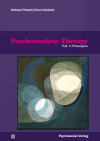Zusammenfassung
The principles underlying psychoanalytic technique and their impact on practice are the main objects of this comprehensive and systematic study, which is based on research in psychoanalysis. By taking the differences between psychoanalytic schools and the finding of related disciplines into account, the authors describe new perspectives. After descriptions of the development of psychoanalysis, chapters are devoted to comprehensive accounts of the key concepts of the psychoanalytic therapy – transference, countertransference, and resistance – as well as to the initiation and conduct of treatment, to the role of models, and to the scientific status of psychoanalytic theory. Psychoanalysis, understood in such terms, can be applied to a broad spectrum of mental disorders and psychosomatic illnesses.
Abstract
The principles underlying psychoanalytic technique and their impact on practice are the main objects of this comprehensive and systematic study, which is based on research in psychoanalysis. By taking the differences between psychoanalytic schools and the finding of related disciplines into account, the authors describe new perspectives. After descriptions of the development of psychoanalysis, chapters are devoted to comprehensive accounts of the key concepts of the psychoanalytic therapy – transference, countertransference, and resistance – as well as to the initiation and conduct of treatment, to the role of models, and to the scientific status of psychoanalytic theory. Psychoanalysis, understood in such terms, can be applied to a broad spectrum of mental disorders and psychosomatic illnesses.
Schlagworte
psychoanalysis mental disorder psychosomatic illness Sigmund Freud history of psychoanalysis- 9–28 Endorsement 9–28
- 141–170 3 Countertransference 141–170
- 171–212 4 Resistance 171–212
- 293–334 7 Rules 293–334
- 335–428 8 Means, Ways, and Goals 335–428
- 483–540 References 483–540
- 541–552 Name Index 541–552
- 553–567 Subject Index 553–567

